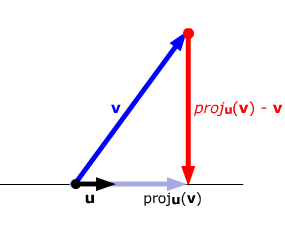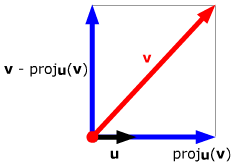
We know that proju(v)
= au for some scalar a. Since proju(v)
- v is orthogonal to u,
we have that (au - v)•u =
0. Multiply out the dot product and solve for a: au•u - v•u =
0, so
a = v•u/u•u.
Then
![]() .
.
![]() .
.
In other words, it doesn't matter whether we choose u or w to represent the direction of the projection; the result is the same projection vector.

Sometimes it is useful to be able to decompose a vector into the sum of two orthogonal vectors. For example, the force of gravity acting on an object sitting on an inclined plane can be decomposed into the sum of a force parallel to the plane and a force perpendicular to the plane. If the force along the plane is great enough to overcome friction, the object will slide down the plane.
 In
general, we want to be able to decompose a vector v into
the sum of a vector in a specific direction (given by some vector u)
and a vector orthogonal to u. From the picture
to the right, it's clear that the vector in the direction of u is proju(v).
Furthermore, since the two blue vectors must sum to v,
the vector orthogonal to u is v - proju(v).
In
general, we want to be able to decompose a vector v into
the sum of a vector in a specific direction (given by some vector u)
and a vector orthogonal to u. From the picture
to the right, it's clear that the vector in the direction of u is proju(v).
Furthermore, since the two blue vectors must sum to v,
the vector orthogonal to u is v - proju(v).
This vector v - proju(v) is called the component of w orthogonal to u. We thus have the orthogonal decomposition
v = proju(v) + {v - proju(v)}.
 Dot
Products of Vectors Dot
Products of Vectors |
||||
| Introduction | Two definitions of dot products | Calculation rules for dot products | Finding angles with dot products | Orthogonal projections |
Sketch a rough copy of this diagram on paper and then sketch in the two vectors proju(v) and projv(u).

